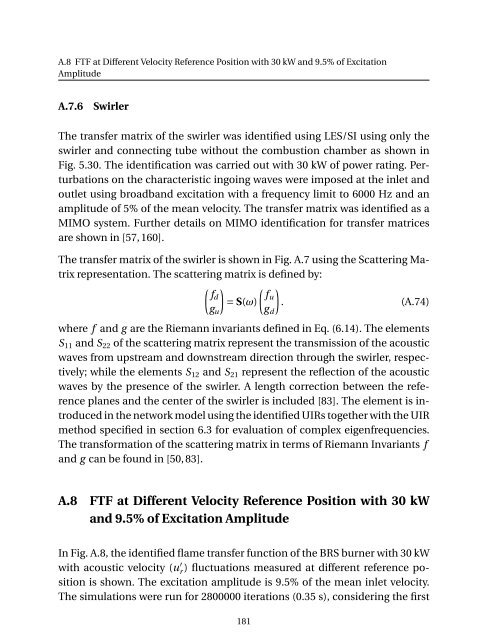Numerical Simulation of the Dynamics of Turbulent Swirling Flames
Numerical Simulation of the Dynamics of Turbulent Swirling Flames
Numerical Simulation of the Dynamics of Turbulent Swirling Flames
Create successful ePaper yourself
Turn your PDF publications into a flip-book with our unique Google optimized e-Paper software.
A.8 FTF at Different Velocity Reference Position with 30 kW and 9.5% <strong>of</strong> Excitation<br />
Amplitude<br />
A.7.6<br />
Swirler<br />
The transfer matrix <strong>of</strong> <strong>the</strong> swirler was identified using LES/SI using only <strong>the</strong><br />
swirler and connecting tube without <strong>the</strong> combustion chamber as shown in<br />
Fig. 5.30. The identification was carried out with 30 kW <strong>of</strong> power rating. Perturbations<br />
on <strong>the</strong> characteristic ingoing waves were imposed at <strong>the</strong> inlet and<br />
outlet using broadband excitation with a frequency limit to 6000 Hz and an<br />
amplitude <strong>of</strong> 5% <strong>of</strong> <strong>the</strong> mean velocity. The transfer matrix was identified as a<br />
MIMO system. Fur<strong>the</strong>r details on MIMO identification for transfer matrices<br />
are shown in [57, 160].<br />
The transfer matrix <strong>of</strong> <strong>the</strong> swirler is shown in Fig. A.7 using <strong>the</strong> Scattering Matrix<br />
representation. The scattering matrix is defined by:<br />
( ) ( )<br />
fd fu<br />
= S(ω) . (A.74)<br />
g u g d<br />
where f and g are <strong>the</strong> Riemann invariants defined in Eq. (6.14). The elements<br />
S 11 and S 22 <strong>of</strong> <strong>the</strong> scattering matrix represent <strong>the</strong> transmission <strong>of</strong> <strong>the</strong> acoustic<br />
waves from upstream and downstream direction through <strong>the</strong> swirler, respectively;<br />
while <strong>the</strong> elements S 12 and S 21 represent <strong>the</strong> reflection <strong>of</strong> <strong>the</strong> acoustic<br />
waves by <strong>the</strong> presence <strong>of</strong> <strong>the</strong> swirler. A length correction between <strong>the</strong> reference<br />
planes and <strong>the</strong> center <strong>of</strong> <strong>the</strong> swirler is included [83]. The element is introduced<br />
in <strong>the</strong> network model using <strong>the</strong> identified UIRs toge<strong>the</strong>r with <strong>the</strong> UIR<br />
method specified in section 6.3 for evaluation <strong>of</strong> complex eigenfrequencies.<br />
The transformation <strong>of</strong> <strong>the</strong> scattering matrix in terms <strong>of</strong> Riemann Invariants f<br />
and g can be found in [50, 83].<br />
A.8 FTF at Different Velocity Reference Position with 30 kW<br />
and 9.5% <strong>of</strong> Excitation Amplitude<br />
In Fig. A.8, <strong>the</strong> identified flame transfer function <strong>of</strong> <strong>the</strong> BRS burner with 30 kW<br />
with acoustic velocity (u r ′ ) fluctuations measured at different reference position<br />
is shown. The excitation amplitude is 9.5% <strong>of</strong> <strong>the</strong> mean inlet velocity.<br />
The simulations were run for 2800000 iterations (0.35 s), considering <strong>the</strong> first<br />
181
















